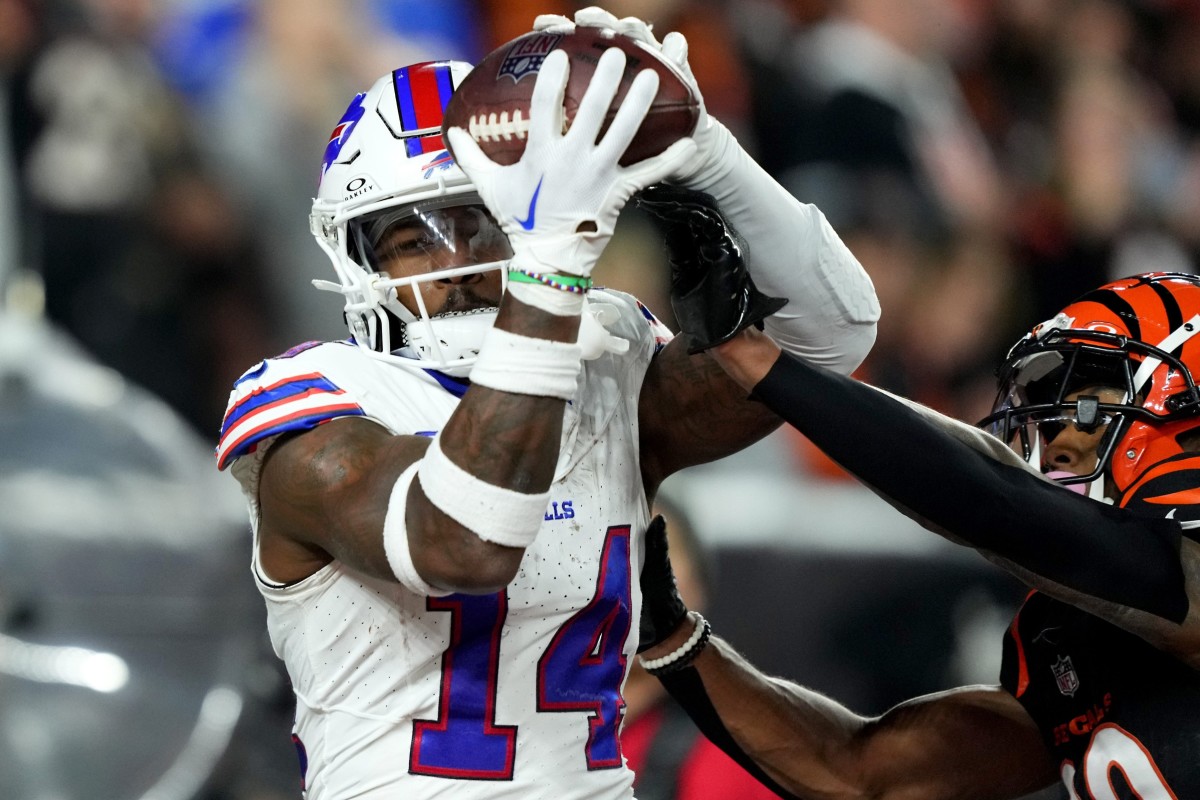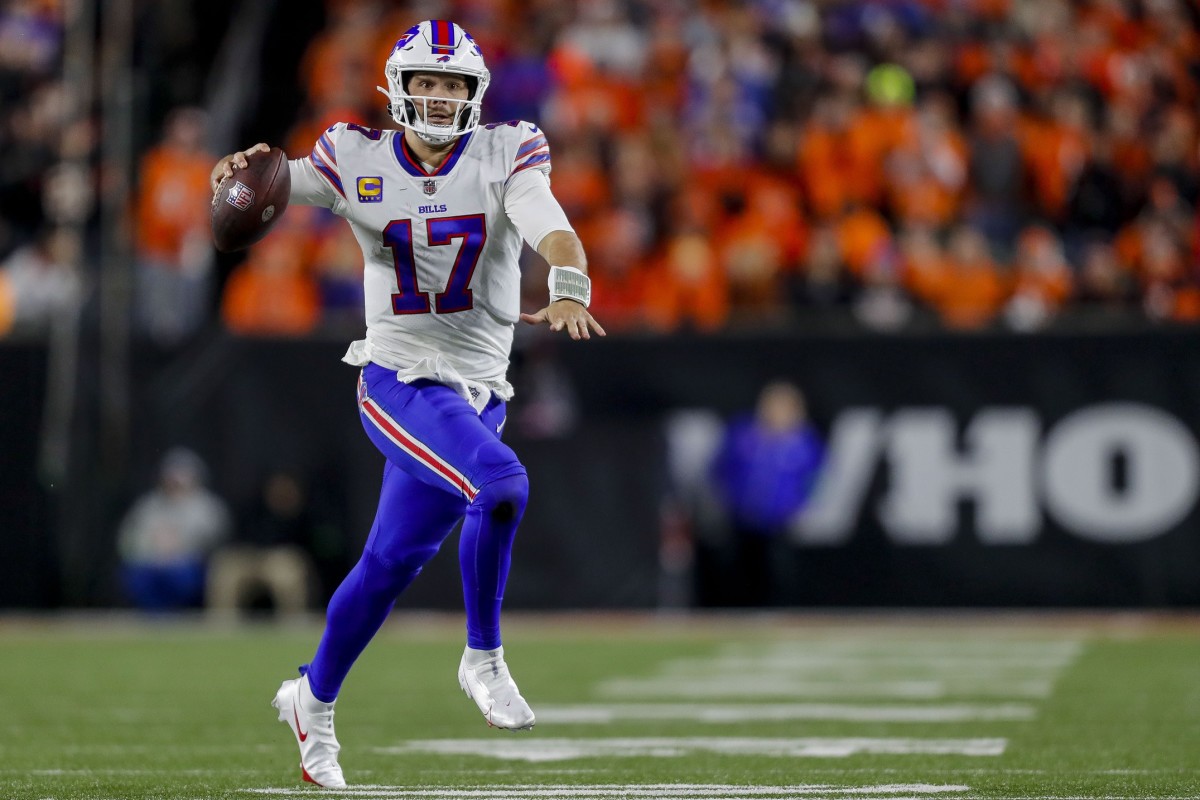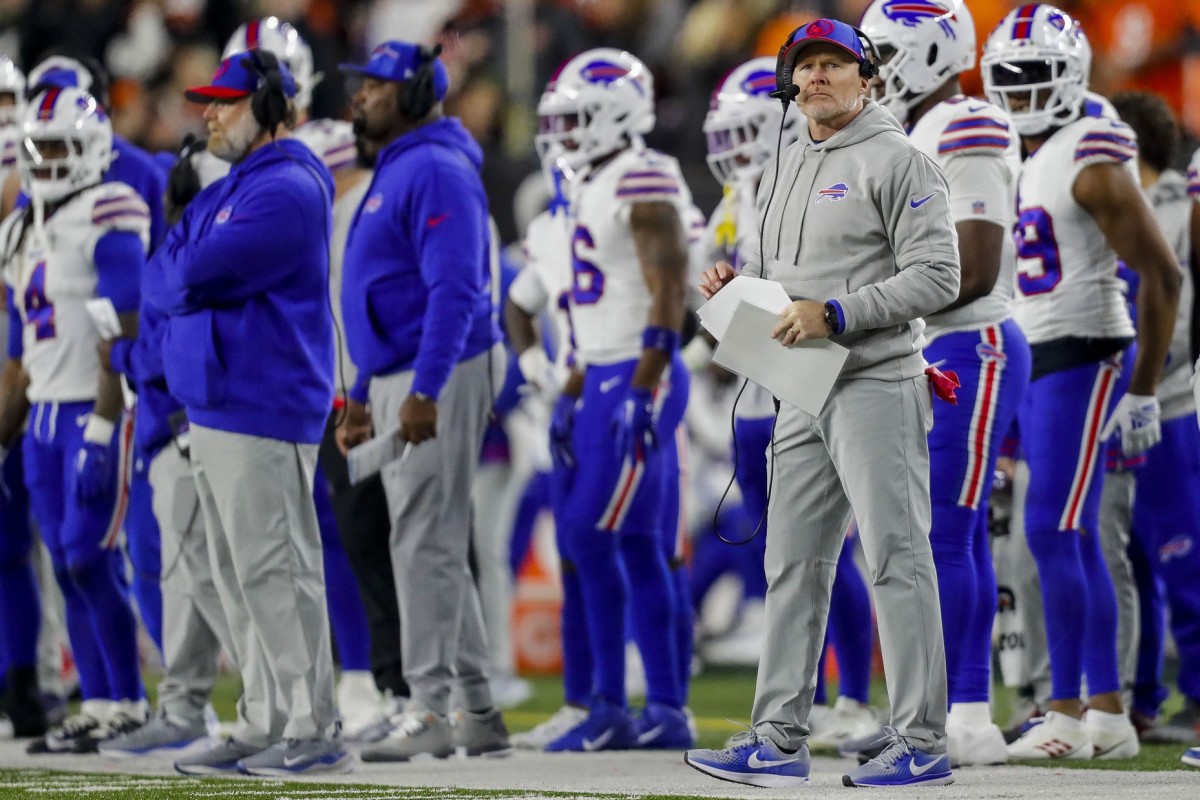A Pro Personnel Rival Scout on the Bills: ‘Who is Buffalo? We Don’t Know.’

One-half of one week past the halfway point of the NFL schedule—you’re complicated, 18-week (17-game) regular season!—the most confounding, see-sawing, what-are-they-comma-really team in professional football is painfully obvious. The Bills are that team, and in terms of moments that befuddle—in both directions—it’s not particularly close.
These Bills fell to the Jets in their opener, despite the injury that ended Aaron Rodgers’s latest season after all of four offensive snaps. These Bills also molly-whopped three consecutive opponents afterward, including the Dolphins the week after Miami put up 70 points. These Bills face-planted in London against the Jaguars, eked out a win over the lowly Giants and inexplicably fell to the just-as-lowly Patriots. These Bills also handled the Buccaneers and, last Sunday, played a rounding-into-form Bengals team close.
As far as consistent elements for success this season, Buffalo can point to only wideout Stefon Diggs and a striking lack of consistency everywhere else. The Bills are 1–2 in their past three games despite an easing of the schedule beyond the Cincinnati clash.

So what’s happening in Buffalo? We found some calls—and studied the Bengals’ tape—to lay out some factors. Main takeaway: There are a lot of factors.
Examining the Bills
Buffalo was considered a legitimate Super Bowl contender in each of the past two seasons—and for good reason. Many thought the Bills had a chance to snag the Lombardi Trophy earlier than that, even.
Late last month, a football analytics website—The Analyst—took a closer look at the Bills’ offense in 2023. The basics informed its study. After all, Buffalo has a franchise quarterback in Josh Allen and an elite-among-elite receiver in Diggs, and there’s plenty of offensive talent around them. They’re also both in their primes after ranking second in yards per play last season, behind only Kansas City.
The study came to an illuminating conclusion that has only worsened in the weeks since. Namely, Buffalo doesn’t have a single major offensive problem. Their 5.6 yards per offensive play is only slightly below what they’ve averaged in each of the past two seasons. They’ve run the ball effectively, passed the ball effectively, scored effectively and done all three effectively, at different points.
That last part—at different points—is the important part. The Bills have several percolating issues that add up to much more. “I see a team that’s all over the place,” says a pro personnel rival scout in the same division who was granted anonymity in exchange for candor. “Who is Buffalo? We don’t know.”
So what gives?
Factor: Injuries
Pity the fool who might consider Allen less than built Ford tough. Whatever might be left for him to prove, it’s not that. Related: Reports have leaked in recent weeks that Allen is enduring pain from a shoulder injury he sustained against the Giants in Week 6. The quarterback didn’t deny the issue to ESPN, but placed this particular injury in the “pain management” category. I asked a Bills source Monday morning whether that was true. They responded over text message: “Yes. Improving. Can play with it.”
Allen’s numbers back both assertions. They haven’t reached light-the-league-on-fire levels the past few weeks. But there hasn’t been a significant drop, either, with Allen throwing for more than 300 yards against the Buccaneers. The more pertinent question is whether that injury is impacting his accuracy, which has been uneven, as evidenced by his past four weeks, starting against the Giants. His completion percentage in those games was: 63.3%, 65.9%, 77.5% and 68.4%. Three of those rank among his lowest single-game percentages of the season, each below his career mark of 71.3%—but accuracy also didn’t hamper him every week, indicating, per the scout, that there’s more than one issue in play.
Factor: Offensive coordinator
The most obvious sports-talk-radio ALL-CAPS take on this is to blame Ken Dorsey, Buffalo’s OC. It is, after all, his offense—one that coach Sean McDermott has not defended in public recently. McDermott, whether speaking his truth or setting up a scapegoat, has criticized his own team for its lack of consistency, its lack of points, the adventurous nature of its play calls and its lack of rhythm. Most of those factors are grounded in truth. All speak to a coach who doesn’t sound confident in his chosen coordinator.
Also, here’s a key point: Allen is on pace to set career lows in carries and rushing yards. Perhaps Dorsey is trying to protect him, in this and future seasons. If so, what’s the corollary impact? Buffalo’s offense ranks fifth in the NFL; its rushing offense ranks 16th, which is down from seventh last season. And because defenses are stuffing Buffalo’s running game, Allen is also struggling on passes thrown more than 20 yards downfield. He’s way down on completion percentage, touchdowns and passer rating for those passes, while his interceptions under the same calculus are up.
So are the Bills a few tweaks—or a coordinator change—away from optimizing their roster and extending their championship window? Or is this roster, while talented, not made for a realistic Super Bowl run? “To be determined,” the rival scout says. “It’s almost never the coordinator’s fault entirely. But they’re usually the first person who’s blamed.”
Factor: Rhythm
No one on Buffalo’s offense has been shy about the importance of rhythm and how they’ve rarely found an ideal version of it this season. The offensive line is healthy. Diggs is balling out. When tight end Dawson Knox has missed time to injuries, rookie Dalton Kincaid has more than capably filled in. If anything, Kincaid has emerged as Allen’s second-favorite option. Everything seems fine, right? Wrong. There’s all that—and no rhythm.
Bills Mafia members seem particularly focused on the offense’s lack of no-huddle offense against the Bengals. When Buffalo ran that scheme, allowing Allen to call plays in real and rapid time, it scored four touchdowns on four drives in the four games before Cincinnati.
Factor: Scoring offense
In nine games this season, the Bills have totaled 16, 38, 37, 48, 20, 14, 25, 24 and 18 points. In the most simplistic way possible, those totals illuminate the lack of consistency better than any advanced metric.
Factor: Allen’s turnovers

On Sunday, Buffalo added two turnovers to its season total. This left the Bills with a zero differential on the season, which ranks 13th but won’t win a team many Super Bowls. Kincaid fumbled against the Bengals. Allen threw an interception, which happens, but in this instance it helped highlight a troubling trend. He has thrown at least one pick in seven of Buffalo’s nine games this season. Guess who leads the NFL in turnover differential? Cincinnati at plus-nine.
Factor: Injuries on defense
Find an NFL team that’s struggling with consistency and chances are, almost always, injuries have played a significant role. The Bills have endured more than their share the past two seasons, especially on defense. Buffalo finished last season with the second-fewest points allowed despite losing a cornerstone in what seemed like every week. According to the late October study, the Bills were allowing 5.3 yards per rush (third-worst in the league), while giving up 3.0 yards before contact (also worst among NFL leaders). At that point, Buffalo was still recording elite pass-defense numbers. But then injuries hit again.
The Bills lost cornerback Tre’Davious White, linebacker Matt Milano and defensive tackle DaQuan Jones, all of whom are on injured reserve. That’s one of the best corners in pro football, one of the NFL’s best linebackers and a run-stuffing defensive tackle. Each left a hole that cannot be filled by a single replacement option at every level of Buffalo’s defense. Since White tore an Achilles and lost another promising season in Week 4, the Bills have been outscored by their opponents. Milano broke his leg, and, while he wants to return this season, whether he will remains an open question for only the most hopeful at team headquarters. That said, Buffalo also lost safety Micah Hyde, linebacker Terrel Bernard and corner Christian Benford against the Bengals—and its defense still played well enough to give the team a chance to win.
Factor: McDermott

What should be most concerning to Bills fans is how all these issues seem tied together, especially on offense, where it’s reasonable to argue that a lack of rhythm; Allen’s “manageable” injury; less of a run game, especially from the quarterback; and play-calling have combined to sink an elite unit. Throw in defensive breakdowns and special teams gaffes, and there’s really only one person who has a hand in all aspects of the Bills’ struggles. That’s McDermott, who threw his offensive coordinator under the bus, backed up, then ran over Dorsey again.
Factor: Consistency
The Bills just aren’t consistent, especially on any one game day. They’ve lost primarily through each of the three main phases in different weeks.
Special teams cost them the game against New England, starting with a missed field goal in the second quarter and a field goal attempt the Patriots converted that was set up by a long punt return. Kicker Tyler Bass has missed three of his 13 field goal attempts. Buffalo’s punt coverage unit has struggled all season.
The Bills’ defense couldn’t stop the Jets in overtime, couldn’t stop New England at the end and on Sunday night couldn’t stop Cincinnati at the end. Because of Allen’s interception and two punts downed inside the 15-yard line, both the special teams unit and Buffalo’s defense ensured that the Bills’ starting field position was the 20-yard-line, which didn’t help, either, especially with a season-low 68 rushing yards produced against the Bengals.
The offensive misfires are well documented, which means Buffalo has played the worst kind of complementary football—and the flip side of that is the Bills are still 5–4. How to read that? Depends on the viewpoint. Maybe it’s that Buffalo has too many issues to overcome. Or perhaps it speaks to the Bills’ capabilities when they can put a game together such as their blowout victory over Miami. In other words, the Bills rank second in point differential, at plus-80 on the season. They’ve lost three games by 15 points combined. Does that mean their losses are sort of fluky? Or that they’re headed in the wrong direction?
So, who are the Bills?
At this point, their playoff odds, according to multiple projection models, hover between 57% and 59%. That’s a far cry from Super Bowl contender. But while time is dwindling, there remains plenty of season left. The upcoming schedule doesn’t look too daunting, beyond this three-game stretch: at Eagles, at Chiefs, vs. Cowboys. The Bills can’t worry about that now. That’s the thing about windows. They open as quickly as they close, and Buffalo’s window of contention appears ready to shift, either way, over the next nine weeks.
